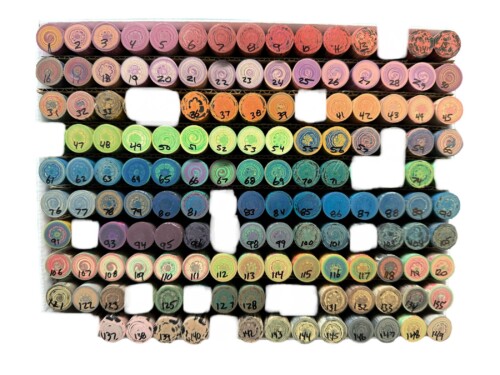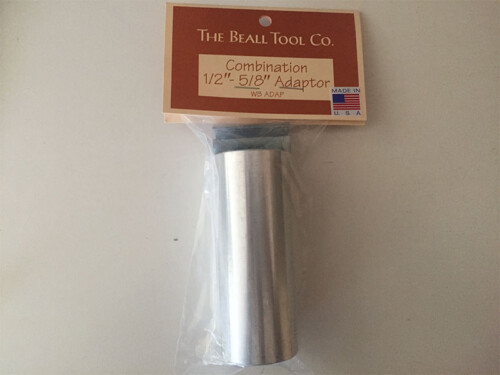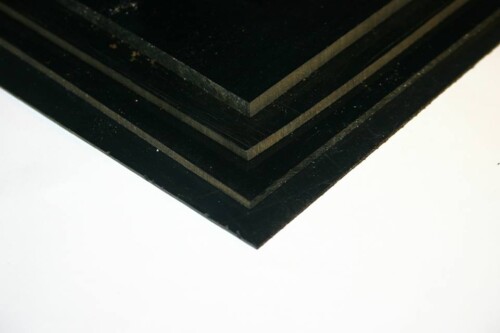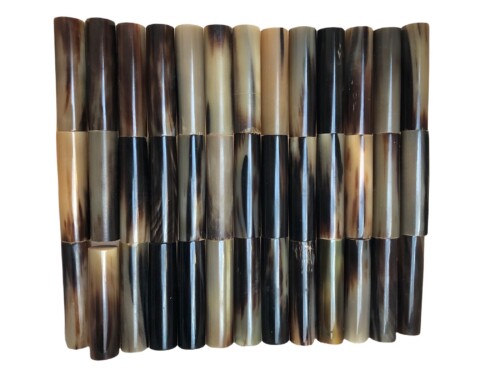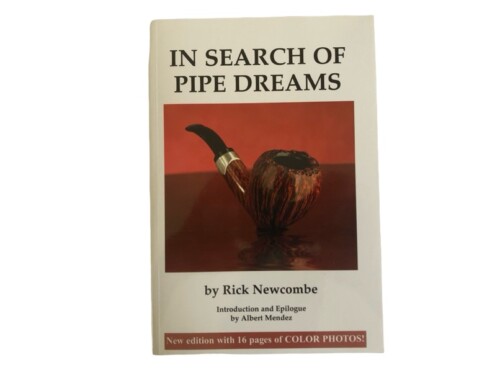-
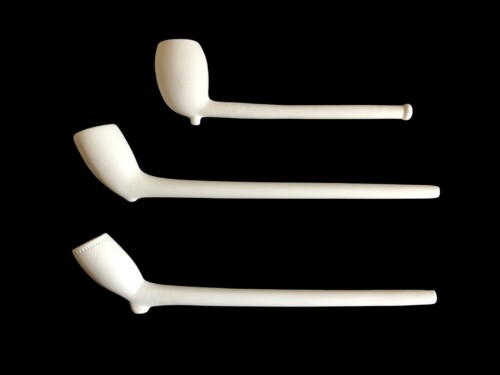 (pipe on top in the picture) The Old Dominion “The Dutchman” clay pipe is a faithful reproduction of a 19th century Dutch clay pipe. This short, stout pipe with it’s easy draw makes it ideal for a large pinch of your favorite tobacco. The Dutchman’s size makes it perfect for storage in the pocket on those long voyages! Whether you need a fantastic smoking pipe or a piece of history, The Dutchman is right for you! These are fashioned from non-toxic, commercially produced clay, and bisque fired, as were the originals. In order to keep the pipes historically accurate, the pipe stems are not glazed. ---------------- (pipe in the middle of the picture) The Old Dominion Williamsburg Clay Pipe is a faithful reproduction of an early 18th century English clay pipe. Fragments of the original colonial-era pipe found on the Old Dominion farm were scanned using a 3D printer, “re-assembled” by computer-aided design (CAD), and reverse engineered to make a master mold with 3D print technology for this clay pipe. These are fashioned from non-toxic, commercially produced clay, and bisque fired, as were the originals. In order to keep the pipes historically-accurate, the pipe stems are not glazed. The “Williamsburg” is named in honor of the renowned 18th century capital of the Virginia Colony (1699-1780). This shorter stemmed version would have been the constant companion for colonial travelers throughout the Colonies as well as British Redcoats and colonial militia on campaign needing a shorter stemmed pipe that was readily compact and less prone to breakage unlike the longer stemmed tavern pipes. It is a great smoker for the tobacco pipe enthusiast or simply as a keepsake souvenir for those interested in the history of Colonial America. ---------------- (pipe on bottom of the picture) The Old Dominion Jamestowne Clay Pipe is a mid- 17th century colonial-era pipe. Fragments of the original colonial-era pipe found on the Old Dominion farm were scanned using a 3D printer, “re-assembled” by computer-aided design (CAD), and reverse engineered to make a master mold with 3D print technology for this clay pipe. Like the original pipe it was copied from, the Jamestowne features a decorative line of milling around the rim of the bowl as well as a defined “heel” at the base of the bowl. These are fashioned from non-toxic, commercially produced clay, and bisque fired, as were the originals. In order to keep the pipes historically accurate, the pipe stems are not glazed. The “Jamestowne” is named in honor of the first successful English settlement in North America. It was a flourishing capital of the young Virginia Colony and a center for colonial trade and commerce. 17th century clay pipes small bulbous bowls were designed to smoke a “pinch” of tobacco at a time when tobacco was still regarded as an expensive commodity. This pipe makes a great taste test pipe for sampling various blends or as a historical keepsake representing the early industry in colonial America.
(pipe on top in the picture) The Old Dominion “The Dutchman” clay pipe is a faithful reproduction of a 19th century Dutch clay pipe. This short, stout pipe with it’s easy draw makes it ideal for a large pinch of your favorite tobacco. The Dutchman’s size makes it perfect for storage in the pocket on those long voyages! Whether you need a fantastic smoking pipe or a piece of history, The Dutchman is right for you! These are fashioned from non-toxic, commercially produced clay, and bisque fired, as were the originals. In order to keep the pipes historically accurate, the pipe stems are not glazed. ---------------- (pipe in the middle of the picture) The Old Dominion Williamsburg Clay Pipe is a faithful reproduction of an early 18th century English clay pipe. Fragments of the original colonial-era pipe found on the Old Dominion farm were scanned using a 3D printer, “re-assembled” by computer-aided design (CAD), and reverse engineered to make a master mold with 3D print technology for this clay pipe. These are fashioned from non-toxic, commercially produced clay, and bisque fired, as were the originals. In order to keep the pipes historically-accurate, the pipe stems are not glazed. The “Williamsburg” is named in honor of the renowned 18th century capital of the Virginia Colony (1699-1780). This shorter stemmed version would have been the constant companion for colonial travelers throughout the Colonies as well as British Redcoats and colonial militia on campaign needing a shorter stemmed pipe that was readily compact and less prone to breakage unlike the longer stemmed tavern pipes. It is a great smoker for the tobacco pipe enthusiast or simply as a keepsake souvenir for those interested in the history of Colonial America. ---------------- (pipe on bottom of the picture) The Old Dominion Jamestowne Clay Pipe is a mid- 17th century colonial-era pipe. Fragments of the original colonial-era pipe found on the Old Dominion farm were scanned using a 3D printer, “re-assembled” by computer-aided design (CAD), and reverse engineered to make a master mold with 3D print technology for this clay pipe. Like the original pipe it was copied from, the Jamestowne features a decorative line of milling around the rim of the bowl as well as a defined “heel” at the base of the bowl. These are fashioned from non-toxic, commercially produced clay, and bisque fired, as were the originals. In order to keep the pipes historically accurate, the pipe stems are not glazed. The “Jamestowne” is named in honor of the first successful English settlement in North America. It was a flourishing capital of the young Virginia Colony and a center for colonial trade and commerce. 17th century clay pipes small bulbous bowls were designed to smoke a “pinch” of tobacco at a time when tobacco was still regarded as an expensive commodity. This pipe makes a great taste test pipe for sampling various blends or as a historical keepsake representing the early industry in colonial America. -
 92 pages, softcover This book tells the story of the first 100 years of Brigham pipes, painstakingly pieced together from corporate archives, historical records, company legend and first-hand accounts from long-time staff at what is now Brigham Enterprises Inc. It is a tale of personal and professional grit, adaptation, invention and survival over three generations, two World Wars, the Great Depression and radical shifts in society’s attitude towards the tobacco industry.
92 pages, softcover This book tells the story of the first 100 years of Brigham pipes, painstakingly pieced together from corporate archives, historical records, company legend and first-hand accounts from long-time staff at what is now Brigham Enterprises Inc. It is a tale of personal and professional grit, adaptation, invention and survival over three generations, two World Wars, the Great Depression and radical shifts in society’s attitude towards the tobacco industry.The quintessential collector’s guide, this book lays out not only the chronology of Canada’s most prominent pipe-maker but also never before compiled information on the pipes themselves, including the stamps, grading schemes and pinning patterns used between 1906 and 2006. Also featured is an updated version of the Brigham Pipes Shape Chart and a full list of Limited Edition pipes.
-
Out of stock
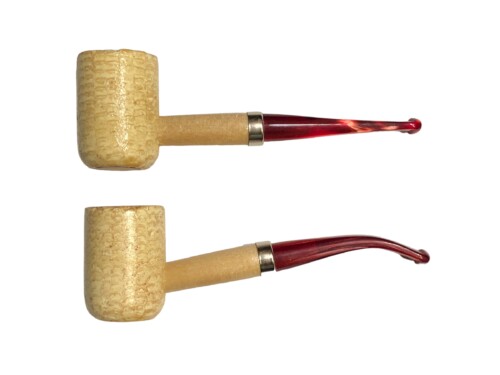 The Washington 5th Avenue Corn Cob Pipe from Missouri Meerschaum is a step above the ordinary corn cob pipe and is part of our series of mid-sized, filtered pipes. The bowl is double filled and spray varnished with a smooth, light-colored finish.
The Washington 5th Avenue Corn Cob Pipe from Missouri Meerschaum is a step above the ordinary corn cob pipe and is part of our series of mid-sized, filtered pipes. The bowl is double filled and spray varnished with a smooth, light-colored finish.Due to the nature of the corn cobs themselves, you may notice some chipping on the top edge of your pipe. This is perfectly normal and won’t in any way affect the way your pipe smokes. The chips only add to the charm and character of your corn cob pipe. Enjoy!
See Product Description below for more details. CLICK HERE to add a Forever stem, they are available in 7 styles and 36 colors -
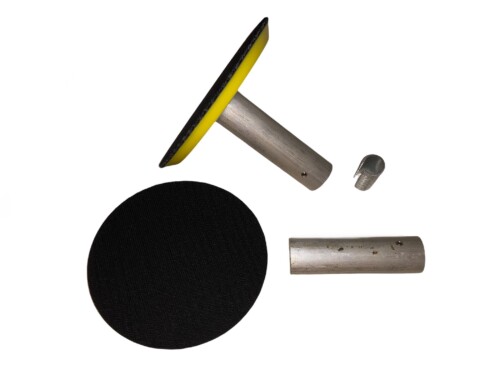 arbor and pad sold separately 5″ hook and loop sanding pads arbor will fit 5⁄8” shaft, locked with set screw adapter sleeve available to convert to 1⁄2” motor shaft (please send note if needed) 5⁄16 x 24tpi threaded bolt coming off pad this uses it's own arbor, which is different from the Beall arbor
arbor and pad sold separately 5″ hook and loop sanding pads arbor will fit 5⁄8” shaft, locked with set screw adapter sleeve available to convert to 1⁄2” motor shaft (please send note if needed) 5⁄16 x 24tpi threaded bolt coming off pad this uses it's own arbor, which is different from the Beall arbor -
Sale!Out of stock
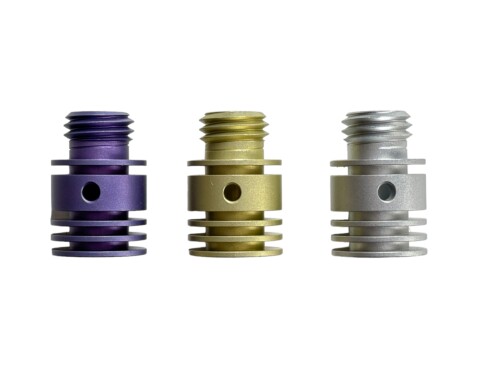 available in 3 colors you will need to ream/drill for stainless steel tubing to have a final fit into the radiator base (hole is drilled in base but is just a little tight for a perfect fit. Reaming is needed) threading is 3/4" x 10tpi if tubing is slightly loose, you can squeeze tube slightly to make a snug fit Loctite 680 is recommended for the final holding in place of stainless steel tubing 1" diameter, 1.5" tall including threaded area
available in 3 colors you will need to ream/drill for stainless steel tubing to have a final fit into the radiator base (hole is drilled in base but is just a little tight for a perfect fit. Reaming is needed) threading is 3/4" x 10tpi if tubing is slightly loose, you can squeeze tube slightly to make a snug fit Loctite 680 is recommended for the final holding in place of stainless steel tubing 1" diameter, 1.5" tall including threaded area -
Out of stock
 slices from acrylic, ebonite, and imitation ivory these are thin small slices
slices from acrylic, ebonite, and imitation ivory these are thin small slices -
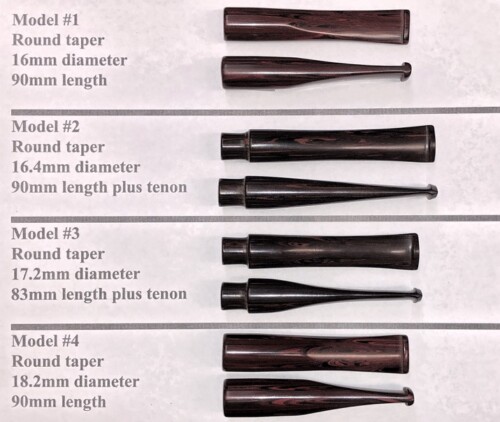
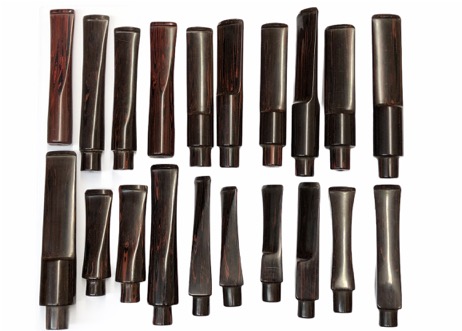 please view chart at bottom of page machined from solid rod stock NYH German red/black Cumberland ebonite new old stock LIMITED SUPPLY, these cannot be reordered these came from an authorized Dunhill repair shop these do not have the white dot airways are drilled diamond and square models have the diameter measured across the flat, not diagonal
please view chart at bottom of page machined from solid rod stock NYH German red/black Cumberland ebonite new old stock LIMITED SUPPLY, these cannot be reordered these came from an authorized Dunhill repair shop these do not have the white dot airways are drilled diamond and square models have the diameter measured across the flat, not diagonal

